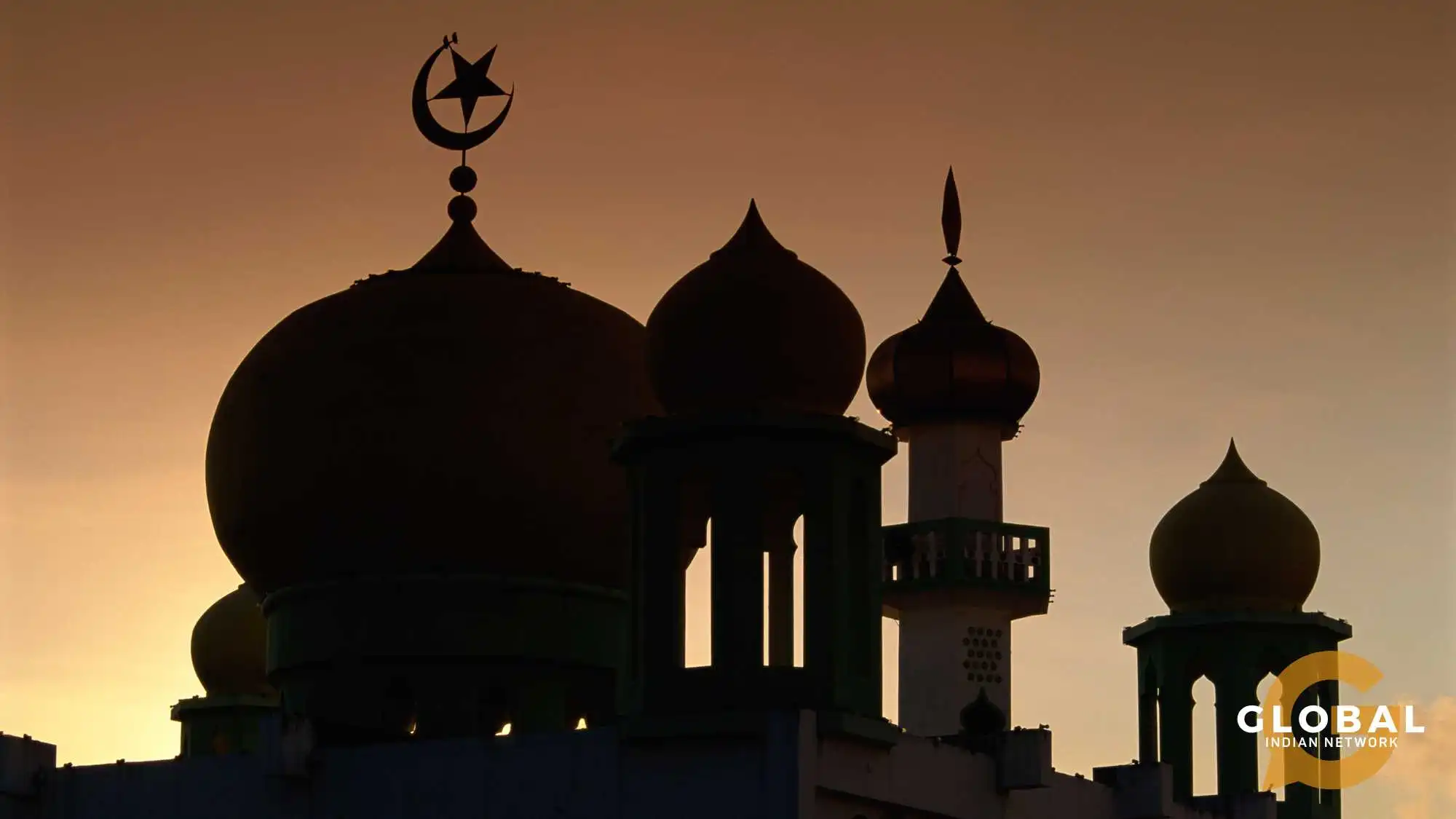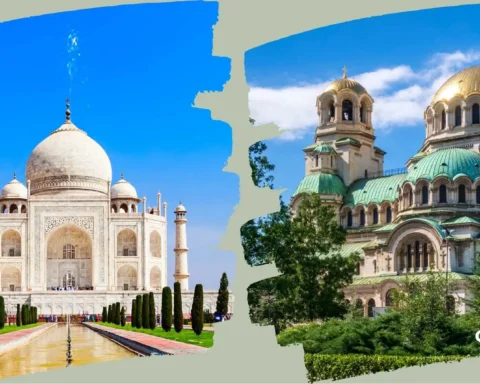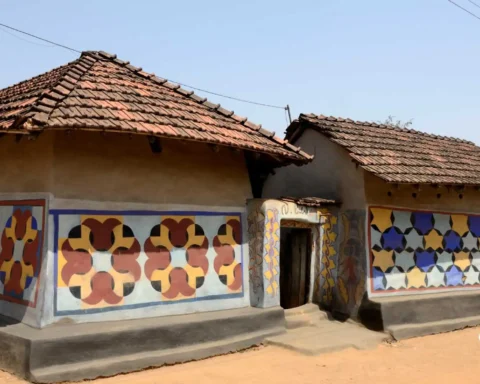Islam is one of the oldest and most widely practised religions in the world. Originally from the Middle East and one of three interlinked religions referred to as the Abrahamic religions, Islam arrived on the western shores of the Indian subcontinent a millennium and a half ago. Since then, the Impact of Islam on Indian society today has grown to encompass many different aspects of life. It has intertwined practitioners and those adjacent in every socio-cultural realm. From Friday afternoon prayers to dress code policies and controversy, one cannot understate the essentiality of Islam in modern-day India.
Table of Contents
Advent of Islam in India
Islam arrived in India while still in its infancy. Trade between the Arab world and the Indian subcontinent predated the birth of Islam. With the advent of Islam in the Middle East, newly converted Arab traders carried this new religion with them alongside their items of trade brought forth during the monsoon season. Consequently, the advent of Islam in India coincided with its formation in Arabia around the 7th Century CE.
Whilst trade and commerce introduced Islam from the south, conquest and warfare brought it in from the North. The Mughal Empire is often the popular reference for Islamic conquest in India, and rightly so, as its ripples are still felt in Islam’s impact on Indian society today. The Mughal invasion was predated by several centuries by the Umayyads, who conquered swathes of the northern part of the subcontinent.

Is There Any Impact of Islam on Indian Society?
Following history’s trail into the modern day is imperative if we are to discuss the impact of Islam on Indian society. It is important to make clear certain distinctions; Islam, like any religion, forms a core basis of someone’s identity. James Meredith Day, in his work, “Religion and Human Development”, argues that “Religion provides a framework for understanding the world, influencing how individuals interpret events and their place in the universe.” Religion is, in essence, a simultaneous effector of the individual and society.
Through this lens, one can view the impact of Islam on Indian society. Having been a part of Indian history for over a millennium, Islam is well intertwined with Indian culture, influencing and being influenced in various stages by several aspects of Hinduism and adjacent cultures that prevail in India today.
The various aspects of Islam, including art, architecture, customs, language, and literature, have become embedded in Indian society today. The Taj Mahal stands as a testament to one of the most iconic representations of Indo-Islamic culture. While this colossal monument represents the grandeur of the impact of Islam on Indian society, there are more implicit societal implications associated with Islam.
When discussing the effect religion has on society, in particular, Islam in Indian society today, it is imperative to tread with caution. This is not only in regard to the hypersensitive nature of India’s socio-political climate but also because misrepresentation of the facts breeds rhetoric.
It is also important to acknowledge that Muslims in India are a religious minority at odds with the nationalistic right to far-right views. It would be dishonest to discuss the Impact of Islam in India without addressing the metaphorical elephant in the room.
Positive Impact of Islam on Indian Society
The impact of Islam on Indian society is a multifaceted and complex topic. Its implications stretch over centuries, with daily life at the intersection of art, music, history, politics, rhetoric, societal standing, and many other nuanced themes.
Perhaps the most prominent positive is the most implicit one, which lies in secularism. India and much of the subcontinent have, for many periods, been accepting of various religious practices. Although not always, at the very least, religions outside the Hindu majority have been tolerated, if not entirely accepted.
The presence of a significant population who identify as Muslim led to secularism being codified in the Indian constitution.
Hindu and Islamic interactions also bore forth a great subgenre of Indo-Islamic architecture. As Muslims came from Arab, Persian and Afghan backgrounds, an incredible nexus of creativity was formed. The Taj Mahal is the most prominent example, but many of India’s historical buildings feature the arches and masonry techniques of Islamic origin.
These features have become so prominently embedded in Indian design that they still appear in many contemporary Indian buildings.
The impact of Islam on Indian society also had an educational aspect. Many of the Islamic traders and ruling class that settled on the subcontinent prided themselves on the acquisition of knowledge. Although educational institutions already existed in the subcontinent, it was through contact with the Arabs and Muslims that we saw a rise in the establishment of institutions and broader sharing of knowledge.

Negative Impact of Islam on Indian Society
The impact of Islam in Indian society is a nuanced matter. Despite its significant contributions to many aspects of Indian culture, like any religious institution, it has had its share of pitfalls.
One major historical event that was the impact of Islam on Indian society was slavery. Although slavery wasn’t a foreign concept on the subcontinent, as words for slaves existed in Sanskrit prior to the introduction of slaves. The commonness of slavery in the Arab world and Islamic culture led to its prominence in Indian society.
When Islamic settlers settled on the subcontinent, they brought with them a culture of societal hierarchy. Though the caste system was already prevalent across India, it was further solidified by influential Islamic figures.
In addition, as Arabic traditions began to influence political rule, conservative interpretations of Islamic doctrine began to take root and were imposed as law.
This led to the acceleration of the subjugation of women in Indian society, which was already present but was significantly worsened in parts of the country.
Conclusion
The impact of Islam on Indian society cannot be taken as wholly good, wholly bad, or anything in between. It is a nuanced area of life that requires close microscopic examination to fully understand and grasp.
In today’s socio-political climate, Indian Muslims are suspended between their national and religious identities. Though secularism remains integral to the Indian constitution, several laws and policies do implicitly or explicitly undermine a Muslim’s standing in Indian society.
As those areas are navigated through the present into the future, it is important to note that Islamic culture is woven into Indian culture, and so is the everyday Muslim. Whether or not they form a small portion of the population is immaterial, as that portion is significant enough to matter.

FAQs
What was Islam’s impact on society?
The impact of Islam on Indian society reshaped the public consciousness in more ways than one. Despite being a monotheistic religion, it inadvertently led to pluralism and secularism in India.
How did Islam spread and impact India?
Islam in India spread as a result of trade, conquest, and casteism. As traders settled in various places, they preached their religion to locals. In a similar albeit less peaceful fashion, conquest from the North West brought with it Islam, as the ruling class sought to establish their religion. Islam was also a refuge for lower caste Hindus, as they sought to escape their lower caste status by converting to other religions.
How did religion impact Indian society?
Religion continues to impact Indian society. Many practices, from dietary choices to festivals, are shaped by religion, which is an integral part of the culture.









